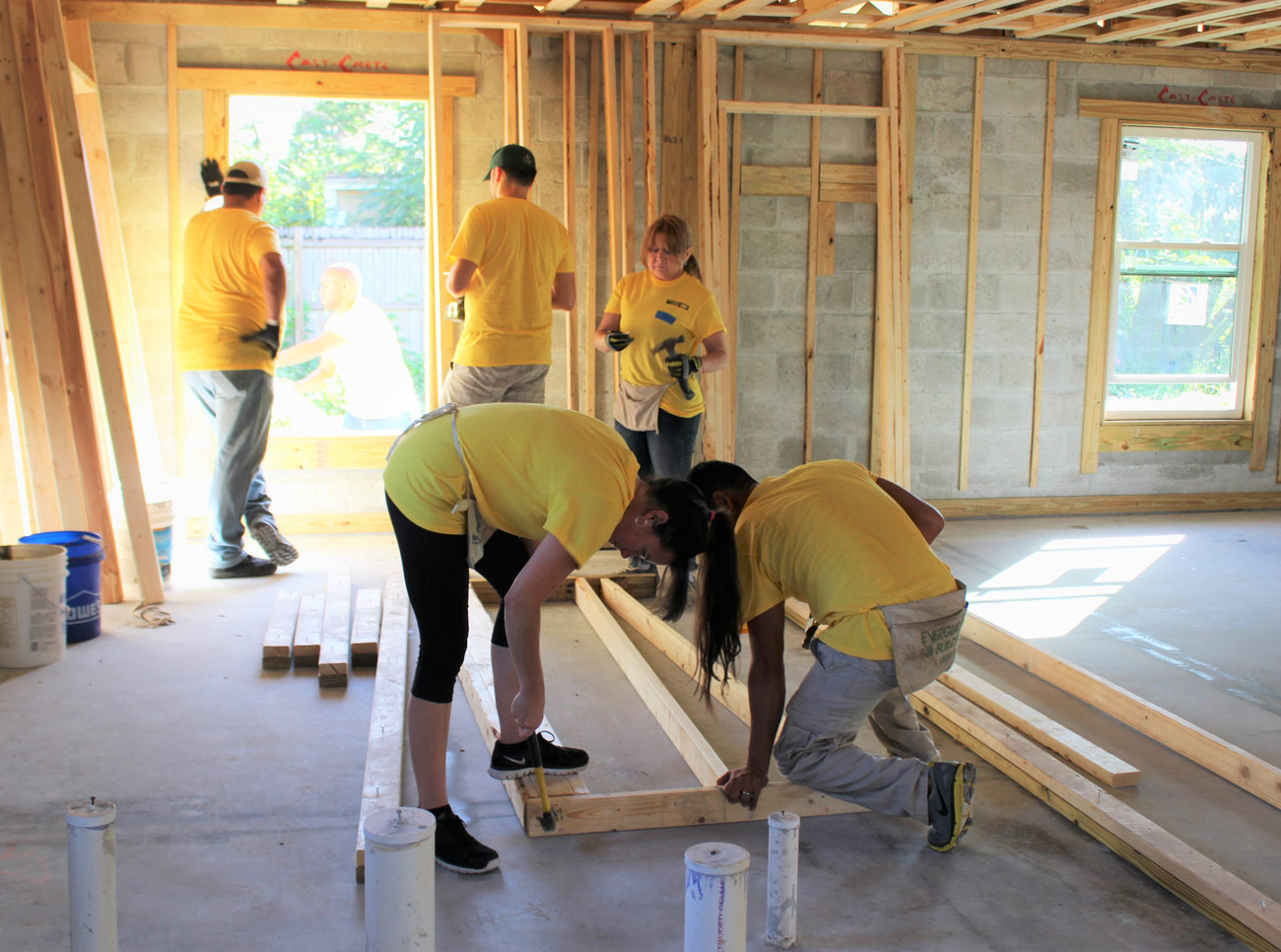<!– –>
<!– –>
<!– –>
<!– –>
<!– –>
<!– –>
By Anna Elise Anderson | December 20, 2017
<!– –>
Volunteers building Habitat for Humanity homes in Miami don’t necessarily follow local building standards — they tend to surpass them. Especially when it comes to elevation to help protect low-income homeowners from sea-level rise and flooding.
The organization “might be better off building boats,” jokes Luis Azan, director of construction for Habitat for Humanity of Greater Miami.
Living in a hurricane-prone region has forced South Florida’s Habitat chapters to focus on features like resistance to high-speed wind and debris impact in the houses they build. Azan lists some of the many ways the Greater Miami chapter has come to build differently than almost all its peers: Concrete block structures instead of wood frames. Solar-efficient glass in windows designed for high-velocity impact. And building houses higher – “sometimes 5-6 inches higher than required,” says Azan.
In a state where the threats of climate change are beginning to drive many decisions about shelter and a livable future, the ways in which affordable housing organizations like Habitat for Humanity respond will serve either as examples for future generations or warnings. Low-income residents face energy inequalities locally and nationally, from spending a higher portion of income on utilities to bouncing back from storms. Those burdens could be exacerbated in the warmer, stormier future that scientists describe for Florida.
But they are not inevitable, as the work of several Florida Habitat affiliates shows.

Barbara Inman, CEO and President of Habitat for Humanity of Florida, says while stricter statewide building codes since Hurricane Andrew in 1992 increased the costs of affordable housing construction in Florida, “the fruits of those investments in both design and capital are apparent after Hurricane Irma hit Florida in 2017.”
Inman says the relatively minor damage from Irma to homes built by Habitat after 1993 “proves that these building codes save money long-term, just as attention to sustainability saves money over the life of a home.”
The same building-efficiency measures that help reduce the carbon emissions warming the planet also help keep residents comfortable and their utility bills low.
Energy Star certification combines greener construction methods with high-performance components like windows and efficient air conditioners, refrigerators and other equipment to reduce energy use within a home. Habitat for Humanity International adopted the certification as a best practice in the United States in the late 90s. Janet McIlvaine, a senior research analyst at the Florida Solar Energy Center at the University of Central Florida, says the requirements “not only save energy but also improve building durability, indoor air quality and comfort.”
Still, Habitat’s culture of local autonomy means Florida’s 57 affiliates may or may not build homes to Energy Star standards. Building practices can differ greatly because of each community’s individual needs, as well as its local board.
The local picture
In Alachua County, energy efficiency has become a priority in home design only in recent years. But construction practices now meet Florida Green Building standards – a new policy adopted “with the purpose of reducing utility bills for our families,” says Scott Winzeler, Executive Director of Alachua Habitat for Humanity.
Chris Fillie, director of construction at Alachua Habitat, says cost savings is still the highest priority – as a charity organization, budget is often of utmost concern in designing and building homes. But he’s quick to note that “cost of energy is a huge factor.”
Under Winzeler’s direction, Alachua has increasingly partnered with local organizations such as the Community Weatherization Coalition and The Sustainable Design Group to better address energy efficiency and weatherization in new and older Habitat homes. “It’s a huge step for them to recognize these issues,” says Mary Alford, CEO of The Sustainable Design Group.
“They’re realizing that a well-designed 1200-sq-ft house ultimately benefits the homeowner more than a less-efficient, larger house,” Alford says. “The smaller design can cost the owner 25 percent less in energy bills and cost Habitat 25 percent less in building materials but still offer the same usability.”
Ultimately, says Ronald Spoor, chief operating officer for Habitat for Humanity of Hillsborough County, local control means the affiliates can figure out how to laser-focus their design and construction practices on long-term livability and resilience. For example, one Habitat community in a flood-prone area near Tampa Bay is building each home at least five feet above current elevation requirements as a measure against sea-level rise and future storm surges.

Southeast Volusia Habitat built the first “zero-energy ready” home in Florida in Edgewater, with solar thermal panels on the roof that provide all hot water for $120 a year. Other Habitat affiliates around the state have followed, sometimes with the help of utilities such as Florida Power and Light. Fillie, the Alachua Habitat construction director, says the local affiliate is working to “figure out a way to incorporate solar energy into our pricing and donation structure.”
The Florida Keys may win the prize for some of the most unusual local practices, developed for resilience to severe flooding and high winds. “All our homes are put on stilts 11 feet high,” says Dan Livingston, site supervisor for Habitat of Key West and the Lower Florida Keys. Along with high winds, the Keys face high construction costs to transport materials to the southern tip of Florida, making Miami’s concrete block frames too expensive. Instead, Habitat of Key West orders pre-built wood-frame homes manufactured in Tampa, with fortifications such as windows rated for 180-185 mile-an-hour winds.
“We’re at the end of the line down here,” says Livingston. Seen another way, his and south Florida’s Habitat affiliates are at the front of the line in building affordable, resilient homes for the climate-changed times.
Up next: Sunny Side »
<!– –>
 Special Report from WUFT News
Special Report from WUFT News